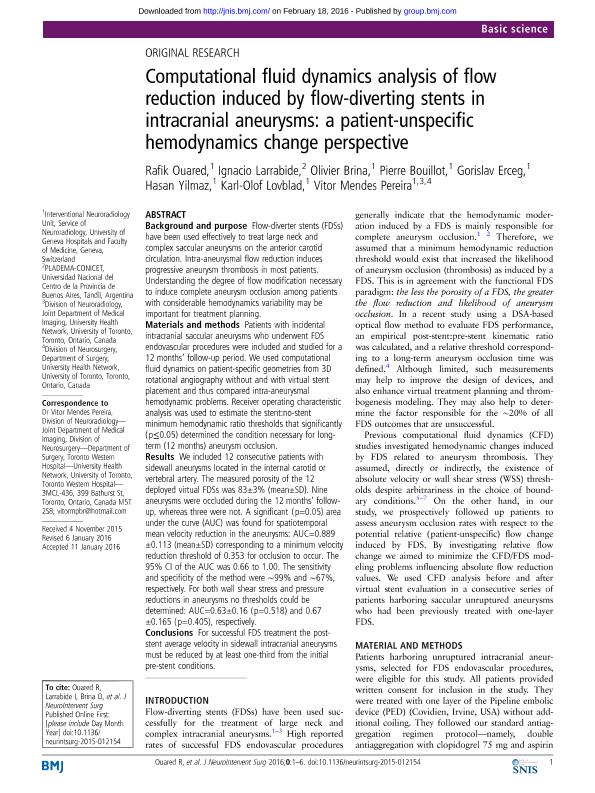Artículo
Computational fluid dynamics analysis of flow reduction induced by flow-diverting stents in intracranial aneurysms: A patient-unspecific hemodynamics change perspective
Ouared, Rafik; Larrabide, Ignacio ; Brina, Olivier; Bouillot, Pierre; Erceg, Gorislav; Yilmaz, Hasan; Lovblad, Kar Olof; Mendes Pereira, Vitor
; Brina, Olivier; Bouillot, Pierre; Erceg, Gorislav; Yilmaz, Hasan; Lovblad, Kar Olof; Mendes Pereira, Vitor
 ; Brina, Olivier; Bouillot, Pierre; Erceg, Gorislav; Yilmaz, Hasan; Lovblad, Kar Olof; Mendes Pereira, Vitor
; Brina, Olivier; Bouillot, Pierre; Erceg, Gorislav; Yilmaz, Hasan; Lovblad, Kar Olof; Mendes Pereira, Vitor
Fecha de publicación:
12/2016
Editorial:
BMJ Publishing Group
Revista:
Journal of NeuroInterventional Surgery
ISSN:
1759-8486
Idioma:
Inglés
Tipo de recurso:
Artículo publicado
Clasificación temática:
Resumen
Background and purpose: Flow-diverter stents (FDSs) have been used effectively to treat large neck and complex saccular aneurysms on the anterior carotid circulation. Intra-aneurysmal flow reduction induces progressive aneurysm thrombosis in most patients. Understanding the degree of flow modification necessary to induce complete aneurysm occlusion among patients with considerable hemodynamics variability may be important for treatment planning. Materials and methods: Patients with incidental intracranial saccular aneurysms who underwent FDS endovascular procedures were included and studied for a 12 months’ follow-up period. We used computational fluid dynamics on patient-specific geometries from 3D rotational angiography without and with virtual stent placement and thus compared intra-aneurysmal hemodynamic problems. Receiver operating characteristic analysis was used to estimate the stent:no-stent minimum hemodynamic ratio thresholds that significantly (p≤0.05) determined the condition necessary for long-term (12 months) aneurysm occlusion. Results: We included 12 consecutive patients with sidewall aneurysms located in the internal carotid or vertebral artery. The measured porosity of the 12 deployed virtual FDSs was 83±3% (mean±SD). Nine aneurysms were occluded during the 12 months’ follow-up, whereas three were not. A significant (p=0.05) area under the curve (AUC) was found for spatiotemporal mean velocity reduction in the aneurysms: AUC=0.889±0.113 (mean±SD) corresponding to a minimum velocity reduction threshold of 0.353 for occlusion to occur. The 95% CI of the AUC was 0.66 to 1.00. The sensitivity and specificity of the method were ∼99% and ∼67%, respectively. For both wall shear stress and pressure reductions in aneurysms no thresholds could be determined: AUC=0.63±0.16 (p=0.518) and 0.67±0.165 (p=0.405), respectively. Conclusions: For successful FDS treatment the post-stent average velocity in sidewall intracranial aneurysms must be reduced by at least one-third from the initial pre-stent conditions.
Palabras clave:
Aneurysm
,
Blood Flow
,
Flow Diverter
,
Stent
Archivos asociados
Licencia
Identificadores
Colecciones
Articulos(CCT - TANDIL)
Articulos de CTRO CIENTIFICO TECNOLOGICO CONICET - TANDIL
Articulos de CTRO CIENTIFICO TECNOLOGICO CONICET - TANDIL
Citación
Ouared, Rafik; Larrabide, Ignacio; Brina, Olivier; Bouillot, Pierre; Erceg, Gorislav; et al.; Computational fluid dynamics analysis of flow reduction induced by flow-diverting stents in intracranial aneurysms: A patient-unspecific hemodynamics change perspective; BMJ Publishing Group; Journal of NeuroInterventional Surgery; 8; 12; 12-2016; 1288-1293
Compartir
Altmétricas



